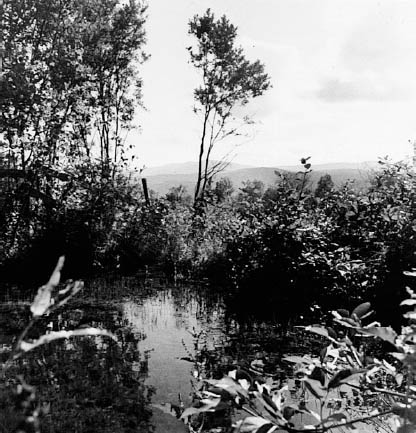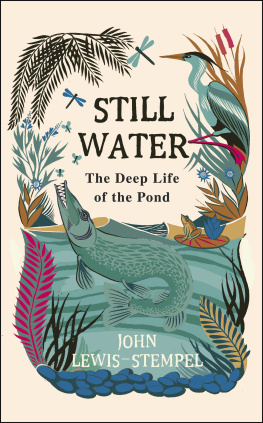EARTH PONDS

EARTH PONDS
The Country Pond Makers Guide
to Building, Maintenance and Restoration
Second Edition, Revised and Expanded
TIM MATSON

Thanks to All Who Helped
Pond Makers & Pond Keepers Leonard Cook, Sonny Stearns, Sherm Stebbins, George Williams, Gordon Wilder, Harold and Calvin Day, Jim Malone, Steve Wetmore, Ralph Stevens, Donny Prescott, Joseph and Flo Morse, Peter Orgain, Woody Ransom, Karl Hammer, Blake and Aletta Traendly, Henry Marckes, Hank McGreevey, Bob Huke, Ray Uline, Ron Hansen and the Eastman community, Mark Lornell, David Talbot, Lila Stutz-Lumbra, Gary Ullman, Ted Kenyon, Sean Mullen, and Dr. John Dwyer.
Neighbors Eric and Cheslye Darnell, Gerard Stevens, and Vi Coffin.
Book People Peter Jennison, Chris Lloyd, and the staff of The Countryman Press, Katinka Matson and John Brockman, Guy Russell, Bob Gere, Jeffrey Nintzel, Gordon Pine, Roger Griffith, and the Sun Photographic Lab & Gallery.
Parts of Earth Ponds appeared in Harrowsmith, Farmstead, and CoEvolution Quarterly.
Book Design by Guy Russell
Illustrations by Diane St. Jean
Typeset by NK Graphics
Photographs by the Author
1982, 1991, 2012 by Tim Matson
Third Edition, 2012
Library of Congress Cataloging-in-Publication Data
Matson, Tim
Earth ponds : the country pond makers guide / Tim Matson. Rev. and expanded ed.
p. cm.
Includes bibliographical references and index.
ISBN 978-1-58157-147-9
1. Water-supply, RuralAmateurs' manuals. 2. PondsAmateurs' manuals.
I. Title
TD927.M434 1991
627'.86dc20
90-26957
CIP
Published by The Countryman Press, PO Box 748, Woodstock, Vermont 05091
Distributed by W. W. Norton & Company, Inc., 500 Fifth Avenue, New York, New York 10110
10 9 8 7 6 5 4 3 2 1
Contents

And like the fishponds of the abbeys and castles of medieval Europe and the Dark Ages, when all the world fell apart in anarchy and disorder, they provided not only food for the table but peace for the soul and an understanding of mans relationship to the universe.
Louis Bromfield
Malabar Farm
For Ellen Langtree
Preface to the Second Edition
Lots of water has gone over the dam in the ten years since the first edition of Earth Ponds. The book was written in the aftermath of the late 70s oil crunch, in a spirit of self-sufficiency and planetary stewardship, about a subject previously confined to farmers and professional aquaculturists. Then during the 1980s, pond building caught on with the public. The economy went through an unprecedented boom, and in its wake thousands of new ponds appeared across the continent, ponds for recreation and fishing leading the way. Water gardening became one of the hottest trends in domestic landscaping, spurring interest in aquatic plants and shrubs that thrive around ponds, as well as methods for maintaining water quality. People began excavating and restoring ponds as refuges for endangered waterfowl and wildlife. Conservation of natural resources, including mandatory wetland construction to offset loss to development, became a national policy. Recently, when the economy took another dive, interest turned again to more frugal methods of pond excavation. At the same time, a combination of environmental regulations restricting pond excavation in sensitive wetland areas, and high real estate construction costs, prompted new interest in pond restoration.
The result is a more sophisticated level of interest in pond use. Hence this new edition. Originally the focus had been on pond construction: siting, design, working with contractors, and excavation; all with an emphasis on saving money by undertaking much of the preparation yourself. But there was another dimension that had been skimmed over: pond care. Gradually, over the past decade, many of the ponds that I helped design began to need maintenance and repairs, including my own. Algae, weeds, leaks, silt, and erosion, all natural signs of pond aging, began turning up. Traditional methods of pond maintenance emphasize toxic chemicals and expensive dredging. Looking for better alternatives, I began to explore aeration, biological management, and structural and hydrological improvements.
Building a pond from scratch is one thing. Reviving an old or ailing pond is another. There it sits. It may be loaded with silt or algae, or choked with weeds. It may leak. Perhaps its empty. The pond may have been dug decades before the present owner took possession of the land, with entirely different, perhaps opposing goals in mind. Yet inside that old swimming hole is a new pond waiting to emerge, often in better shape than the original.
In the Pond Care chapter you will discover a wide spectrum of up-to-date, efficient techniques for bringing ponds back to life. For example, inexpensive flexible plastic piping makes it easier to feed ponds supplementary water, reviving structures that might have been previously abandoned or bulldozed under. Hydraulic excavators allow for quick, surgically accurate edge cleanups. PVC liners and other leak-proofing methods can be used to hold water in porous ponds. Aerators give dead waters new life, and hybrid fish gobble up intrusive weeds and algae, eliminating the need for chemicals.
Pond restoration can be tricky. In many instances, the pond should be emptied. That brings up the matter of drainage, which must be handled so that downstream areas are not damaged by flooding or silt. If a pond is to be cleaned .
Choosing a method of water quality control requires thinking about not only your pond, but your downstream neighbors water supply as well. Chemicals can be used to kill algae and weeds, but they also can kill fish and bacterial life, and may contaminate the watershed. In many cases, manual removal of intrusive plants is best. Often aeration is offered as a non-toxic panacea for everything from algae to fish kills, but there are several different types of aerators, each with a different capacity for water quality improvement. Careful selection is required to match the pond and equipment. In the Controlling Pond Weeds and Algae, and Healthy Ponds Need Plenty of Fresh Air chapters, you will learn about different plant and water quality maintenance methods, including aeration methods and applications.
Interest in pond solutions should not be limited to water quality and structural repairs alone. Ponds also can be used as solutions in themselves to provide refuge for endangered waterfowl and wildlife. Shallow man-made ponds can be used to offset wetland losses to development and agricultural drainage. This suggests new uses for old marshy ponds and shallow bays, until recently neglected or eliminated by designers and owners.
I often suggest to people repairing ponds that part of the shoreland be allowed to remain wild. Rather than creating a totally manicured appearance, preserving a stretch of brush and emergent vegetation will offer cover and food for wildlife. Pond owners who try this are usually rewarded with an increase in visits from waterfowl and wild critters. Wild game food nurseries offer seeds and root stock for plants especially attractive to wildlife. In Ponds for Waterfowl and Wildlife you will learn how wildlife pond design and plantings create such solutions, and the expanded appendix lists sources of seeds and root stock.
Next page














